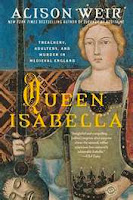Without a doubt, Alison Weir is my favorite biographer. Usually focusing on famous female historical figures she has written biographies on Queen Isabella, Eleanor of Aquitaine, Mary Queen of Scotts, Queen Elizabeth I, as well as Henry VIII and his children.
Lady in the Tower is her newest biography and focuses exclusively on the months leading up to Anne Boleyn’s trial and execution.
Weir puts to rest the notion that Henry VIII was behind the accusations of adultery, incest and treason leveled against Anne in May 1536. Most people have seen Anne’s fall as a result of marital discord, but Weir notes that such a view is too simplistic. In fact, sources noted that up until she was accused of her crimes she was still “the person who manages, orders, and governs everything, whom the King does not dare to oppose” (54). Weir paints a picture of a Henry VIII who was very much still in Anne’s thrall, though her power had waned considerably since she was unable to produce a male heir.
How did Anne became the victim of “the most rapid and bloody political crises of the century”? (72).
Weir places the blame solely at the feet of Henry’s chief minister, Thomas Cromwell, who believed Anne posed a threat to his policies as well as his life.
Anne still influenced the King regarding religion, and was against Cromwell’s dissolving England’s monasteries and using the money for the crown. She was also behind the execution of Cardinal Wolsey, one of the most powerful men in all of England. It was also widely believed that her faction was also behind the poisoning attempt of John Fisher, the Bishop of Rochester.
Weir makes it clear that in the world of court politics Anne and her family were powerful enough to take down Cromwell, leading him to destroy Anne. Her cruel treatment of Mary (Henry’s only legitimate child), her difficult behavior, and her highly flirtatious manner with men only helped Cromwell as he sought to build a case against her.
When she and five men (one being her brother George Boleyn) were accused of adultery, incest and plotting the King’s death the entire Kingdom was shocked.
Weir makes it clear that Henry waited until all of Cromwell’s evidence was laid out until he finally believed that Anne had cuckolded him and sought his death. Instead of the cruel and evil tyrant who simply wanted Anne out of the way, Henry was in fact humiliated by the charges and removed himself from the public eye until the trail was over.
As with her previous books, Weir excels as creating the feel and mood of an era. When describing Anne being taken to the Tower of London, where she will be held as a prisoner, Weir is quick to point out that the Tower did not hold the sinister symbolism of later years. She also uses legal documents, budgets, and supply lists to paint a vivid picture of the daily life of Anne and her daughter.
Though it is widely known the charges against Anne were most likely untrue, Weir uses her knowledge of court life to point out the near impossibility of committing adultery. Constantly surrounded by her ladies in waiting, Anne would have found it impossible to sneak around with a single lover, let alone five. Weir also notes that since not one of her ladies was arrested for aiding her adultery, it can only be assumed it never happened.
The twisted, venomous atmosphere of court life comes across in Weir’s research. She records that former friends and family members wasted no time switching their alliances to Henry’s newest paramour, Jane Seymour, once it was clear that Anne and her faction were headed for ruin. Anne’s own mother and father stood by as she and her brother were killed in order to save their own skin.
Weir also notes that Anne’s main accuser was her sister-in-law Jane Parker. Parker would later be described as possessing a meddlesome personality, and ironically would be put to death for aiding Henry’s fifth wife (Katherine Howard) in committing adultery.
In the end, Anne and five men were put to death for treason. Anne’s death came last, and while burning was the normal penalty for women who committed treason, it seems that Henry wanted to avoid a gruesome spectacle. Anne was kept in the dark about how she would die, and her anguish was used as a political tool to get her to agree to annul her marriage in exchange for a less painful death. However, it seems Henry had already summoned a well-known executioner from Calais before her trail was even over.
Queen for only three years, Anne was put to death at the age of thirty-five. If not for her daughter Elizabeth’s return to the throne, Anne’s legacy may been more different.
Some of my other favorites from Weir are:




